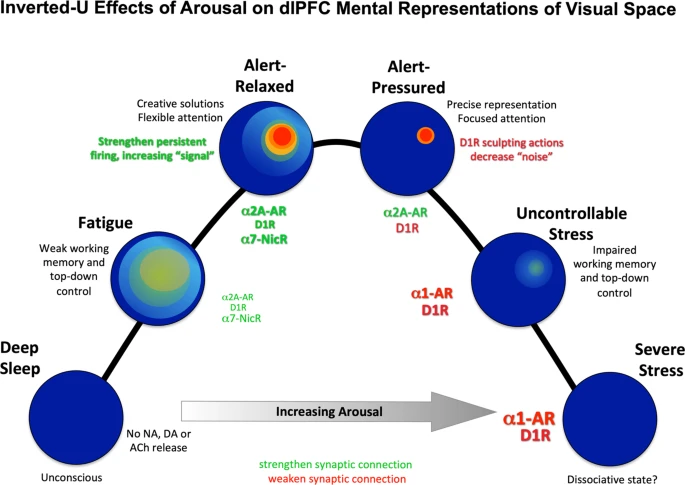Working Memory
2022-03-24: reference:
Working Memory #
-
Working memory can be divided into:
- Verbal
- Storage: posterior Parietal Lobe
- Rehearsal: partially Broca’s Area
- visuospatial components
- Storage/rehearsal: frontal/premotor modulation of Parietal Lobe, Inferior Temporal, and Occipital Lobe
- Verbal
-
On Rhythms in Neuronal Networks with Recurrent Excitation
- Recurrent excitation can sustain activity even when the cells in the network are driven below threshold, too weak to fire on their own. This sort of “reverberating” activity is often thought to be the basis of working memory.
-
Cellular basis of working memory (Goldman-Rakic 1995)
- The key features of the canonical PFC microcircuit with spatially tuned mnemonic delay period activity are (1) persistent activity created by mutual excitation between pyramidal neurons with similar spatial properties, and (2) spatial tuning regulated by inhibitory interneurons with dissimilar spatial properties.
- Recurrent connections allow neurons to fire during the delay period, maintaining representations even in the presence of distracting stimuli. This is a fragile process. Enter the signal-noise discourse.
- Recurrent microcircuits concentrated in dlPFC layer III.
- The task-related firing of Delay cells is only subtly reduced by AMPAR blockade, but instead depends on NR2B: NMDA Receptors Subserve Persistent Neuronal Firing During Working Memory In Dorsolateral Prefrontal Cortex
- The key features of the canonical PFC microcircuit with spatially tuned mnemonic delay period activity are (1) persistent activity created by mutual excitation between pyramidal neurons with similar spatial properties, and (2) spatial tuning regulated by inhibitory interneurons with dissimilar spatial properties.
-
I ask “how could Caffeine impair working memory”? And got a thesis on the fundamentals of D1-dependent (dl)PFC function and how it contributes to working memory:
- PV Interneurons: Critical Regulators of E/I Balance for Prefrontal Cortex-Dependent Behavior and Psychiatric Disorders
-
A dopamine gradient controls access to distributed working memory in the large-scale monkey cortex this is some 200 IQ shit.
- Depletion of dopamine from the prefrontal cortex and complete ablation of the prefrontal cortex cause similar working memory deficits
- Too little or too much presynaptic PFC D1 stimulation disrupting delay period activity:
- [A novel dopamine D1 receptor agonist excites delay-dependent working memory-related neuronal firing in primate dorsolateral prefrontal cortex]
-
Inverted-U dopamine D1 receptor actions on prefrontal neurons engaged in working memory (Vijayraghavan, Arnsten, et al 2007)
-
 delay cell firing. Low levels of D1 receptor stimulation are associated with noisy neuronal representations of visual space
delay cell firing. Low levels of D1 receptor stimulation are associated with noisy neuronal representations of visual space
- As for left vs. right while still being optimal, it’s something like creativity vs. focus.
- D1 agonists had suppressive effects on firing of PFC neurons engaged in working memory tasks: moderate levels of suppression preferentially reduced firing to NPDs, leading to an enhancement in spatial tuning, whereas at higher levels of D1R stimulation, physiological suppression became overwhelming, leading to losses in spatial information capacity and detuning of spatial memory-related information
-
-
Dorsolateral Prefrontal Contributions to Human Working Memory
- DlPFC damage was associated with deficits in the manipulation of verbal and spatial knowledge, with left dlPFC necessary for manipulating information in working memory and right dlPFC critical for manipulating information in a broader range of reasoning contexts.
- Monitoring operations are thought to support the active retention of information in WM and computational mechanisms for manipulating items are recruited for updating/selecting between these representations:
-
Free time, sharper mind: A computational dive into working memory improvement
- “Fanning-out” effect: removing time constraints improves WM since more networks are able to be included, as opposed to information being stored in regions/circuits with a decay time
- Mechanisms such as decay and refreshing, as well as models based on the replenishment of encoding-resources, were not supported by our data.
attractors #
- From Principles of Brain Dynamics:
- Attractor networks of spiking neurons are dynamical systems that have the tendency to settle in stationary states or fixed points called “attractors,” typically characterized by a stable pattern of firing.
-
50 Years of Persistent Activity: Quo Vadis?
- Attractor state = consistent with temporal variations
- The mutiple-attractor network model of self-sustained mnemonic persistent activity: a memory representation is not a transient signal that passively decays away in time, instead, it corresponds to a dynamically stable state of the brain. A working memory system is in turn conceptualized as a neural circuit endowed with multiple attractor states encoding different memory items that coexist with a baseline state
- a sufficiently large transient input can switch the system from rest (one valley/basin of attraction) to a stimulus-selective mnemonic state (a different valley) which remains after stimulus withdrawal; such a state is robust against small perturbations (gentile taps of the ball with a club). A subsequent brief but potent signal can switch the system back to the resting state, thereby erasing a memory trace.
- Attractor and integrator networks in the brain byootiful figures
Chunking #
- The Magical Number Seven, Plus or Minus Two: Some Limits on our Capacity for Processing Information (1956)
-
Working Memory and Intelligence: The Same or Different Constructs?
- There’s a significant correlation between working Working Memory capacity (think 7 $\pm$ 2 chunks, a theory established back in 1956!) and Intelligence/IQ.
- The definition of a ‘chunk’ is unclear. Investigation: How Big Is a Chunk? (Simon 1974)
- There’s a significant correlation between working Working Memory capacity (think 7 $\pm$ 2 chunks, a theory established back in 1956!) and Intelligence/IQ.
- Explaining the high working memory capacity of gifted children: Contributions of processing skills and executive control
- There is also a spike model that is stochastic and resolution-based, where quality and quantity has an inverse relationship, without a discrete number to anything.